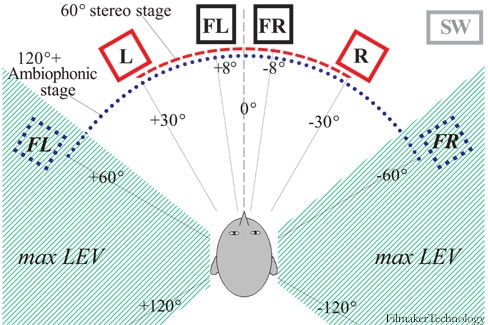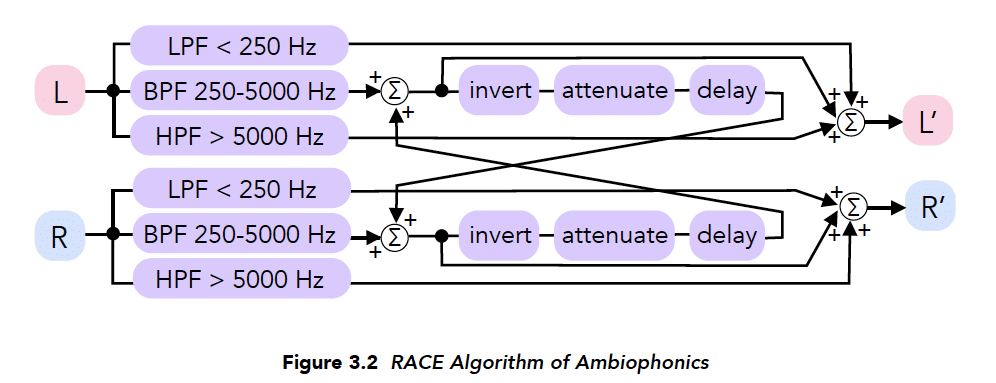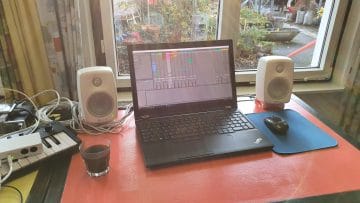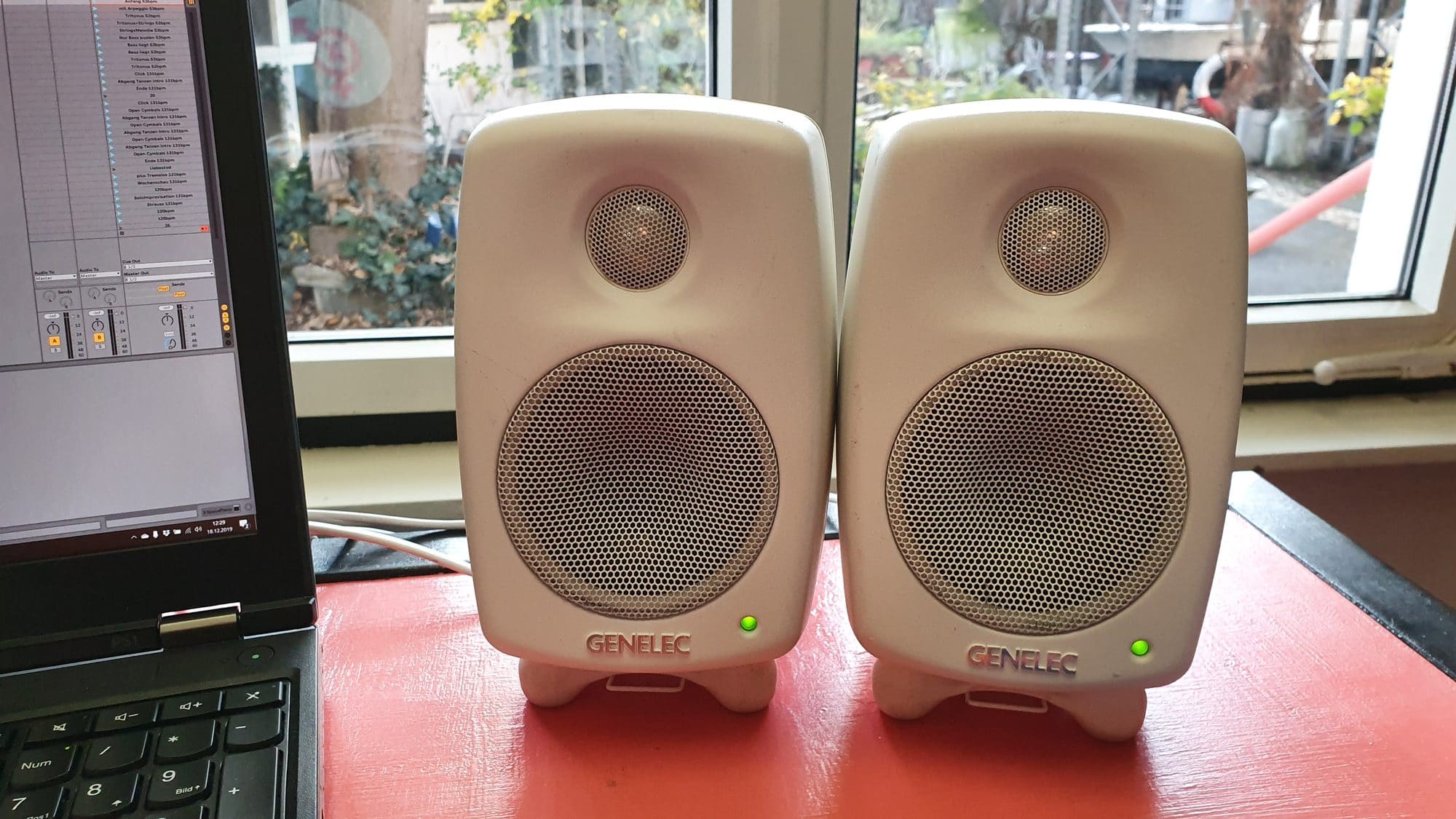Ambiophonics is a less obscure matter than I thought. At first I thought it was just one of the usual phasiness causing improvements for the worse in the sense of pseudo-stereo, but the technique has real potential. Especially for installations, for example.
Wrong directional cues and pseudo-stereo
The kinship to pseudo-stereo is given. Roughly speaking, by inverting the phase on one of the two stereo channels, the crosstalk of one loudspeaker is reduced to the two ears. A right loudspeaker becomes also a left loudspeaker because it is also heard by the left ear, although more quietly. If it is now achieved that the left ear hears less from the right loudspeaker and vice versa, the perceived stereo width increases. You know this from headphones, where there is almost no crosstalk.
Those who have already worked with center speakers will also know that a phantom center (the sound impression that is created when the same signal is emitted by both speakers in the stereo triangle in the same way and is therefore perceived from the center between the two speakers) sounds significantly different than a real speaker for the center. This has to do with the fact that the pinna colours the sound differently depending on the direction from which the sound comes. It does this to give the brain clues from which direction the sound is coming. The most neutral and linear sound comes from the middle front. Only then does the sound arrive at both ears at exactly the same time. If the sound comes from further to the right, not only does the pinna colour the sound differently, but the slight delay with which the sound reaches the left ear creates a comb filter effect, which in turn colours the sound event.
Ambiophonics and the RACE Algorithm
Ambiophonics takes the two speakers and places them extremely close together in front of the listener. This initially results in the signals from both speakers reaching the ears as unfiltered as possible. Trained stereo listeners like me raise a frown and ask: and how should the stereo base width be achieved? Normally, the speakers are positioned in an equilateral triangle, i.e. at an angle of 60° to the listener. Between the two loudspeakers the spatial-sound events take place. If the base width is now reduced to 10-20°, one would actually expect a slightly wider mono. So, good sound that is present, but mono?

Ambiophony involves a strategy of delay. No, not the famous procrastinating before the task, but a network of delays and inverting feedback loops that ensures that the signal from the right speaker is suppressed in the left ear and vice versa (crosstalk cancellation filter). In the simplest case, the left speaker also plays the signal of the right speaker, but phase-inverted and delayed just enough that this phase-inverted cancellation signal reaches the left ear at the same time as the original signal from the right speaker. This causes it to be cancelled and – at least theoretically – the signal from the right loudspeaker can no longer be heard in the left ear.

However, if our crosstalk-reduction device outputs a cancellation signal to the left speaker to cancel the signal from the right speaker to the left ear, the cancellation signal is unfortunately also heard by the right ear. Early crosstalk prevention devices, such as the Carver/Sunfire hologram and Lexicon’s Panorama, were content to erase the signal from the right speaker on the left ear and ignore the fact that the erasure signal was heard by the right ear. More modern algorithms like RACE use a recursive approach: the cancellation signal we just output from the left speaker is fought in a next step with another, slightly quieter cancellation signal from the right speaker. And this again with a further, again slightly quieter cancellation signal at the left speaker. And on and on until nothing more of the cancellation signal can be heard.
If you want to delve more into the technical subject matter, please refer to this article by Ambiophonics founder Ralph Glasgal: Understanding and Installing an Ambiophonic System, to be found on the generally very strenious website on the topic ambiophonics.org.
This technique is very easy and impressive to try out via the ARIA-3D Plugin for Chrome with imposing audio examples on the website aria3d.com.
Conclusion
One promise of ambiophonics is greater clarity of sound, if only because the spatial perception of sound is no longer distorted by false pinna information. One reason why the phantom center is so unstable and spongy is that the pinna puts the filters for the direction half-left and half-right over the sound, even though the sound is supposed to come from the front center. This is where the different perception systems of human hearing come into conflict with each other. If the signals are actually coming from the front of the centre, like from a centre speaker, it sounds much more direct and clear. The simple result: singers, for example, actually sound much more lifelike in ambiophonics!
Now to the question: does a stereo width emerge? Yes, indeed! Not only much more than you would expect and even much more than you know from usual stereo setups. It is actually quite impressive. To my surprise, the effect doesn’t only work at the listening position in the middle in front of the speakers, but also covers partially a wider listening area than with conventional stereo.
But why don’t I always want that now?
But why don’t I always want that now? Well, as a sound nerd, I don’t like the fact that the recursive delays on signals with fast transients can be perceived as sound distorting. For me as a producer whose work is 99.9% heard on non-ambiophonic equipment, it makes no sense to produce on an ambiophonic system.

Also, at some point I found it annoying that the main direction of the sound was coming from *next* to my laptop and not, as usual, as phantom center out of the laptop.
But in environments where you have the speaker placement under control, such as in the theatre or in sound installations, it makes perfect sense to work with this technique. In situations where the base width is too small for architectural reasons, e.g. in a sculpture or at the back of the stage, the perceived stereo width can be massively increased. Another interesting experiment could be to work in stereo with two center clusters hanging close together. This is because a centre cluster is physically far superior to loudspeakers on the side for evenly distributed sound in a spectator area. Two of them in ambiophonic mode should produce a very crisp and present, yet broad sound image.
In any case, ambiophonics is another interesting and powerful tool for the sound designer. It is easy to make and solves problems in an original way. I am curious how I will use this technique.
Translated with the help of www.DeepL.com/Translator (free version)


